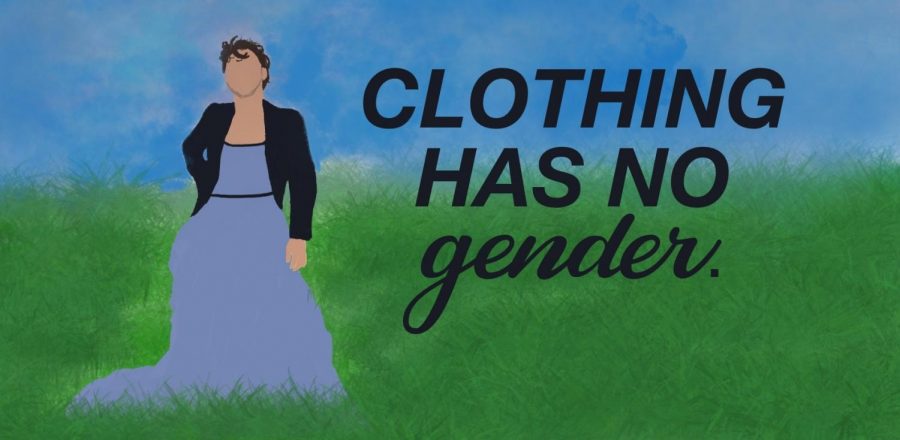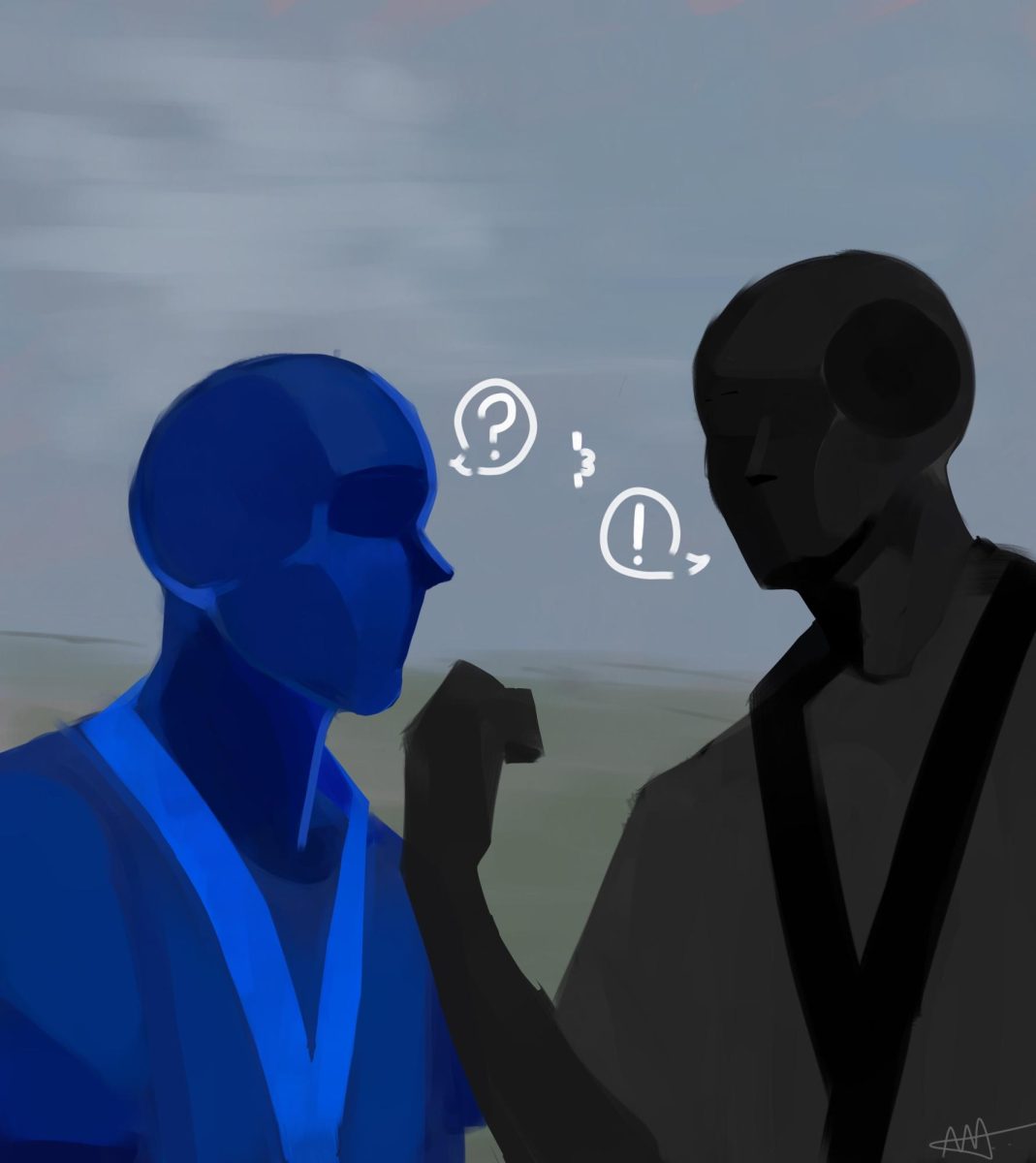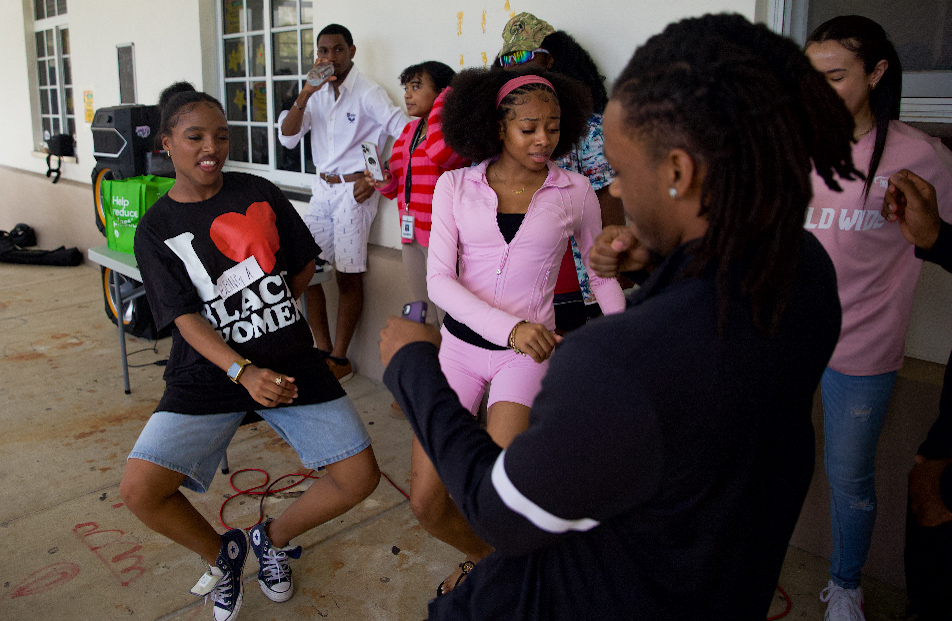Amid a cloudless sky, Harry Styles inflates a cyan bubble. He is dressed in a black, tailored blazer and a faint blue dress with black lace accents. Adorning each of his fingers are gold rings, some accented with vibrant jewels.
Through many realms of our culture, gender has massively influenced the expression of individuals; this vastness of expression has been set into boxes, confined to the letters on a birth certificate. Now, many are breaking away from these molds, challenging structured industries with their individuality. Many are blending male and female into a simpler form: human. Androgyny combines traditional gender characteristics to create a style that is no longer inhibited by the standards set by society.
Founded in 1892, Vogue has featured hundreds of celebrities on their covers, all with their own unique photoshoots and outfits. All of these covers featured women, leaving men, quite literally, out of the picture. This year, singer-songwriter Harry Styles made history as the first solo male to ever appear on the cover of Vogue’s December issue. Donning dresses, kilts, and even a tutu, Styles has completely disregarded societal norms, expressing himself through a flamboyant sense of style, pulling inspiration from personal idols such as Elton John and David Bowie, known for their extravagant styles within the music industry.
Previously, nine other men have been featured on the magazine, though they were accompanied by a female counterpart. Styles’ appearance on the cover certainly came as a surprise to many. For many, it was inspiring to finally have male, androgynous representation in a place of prestige. In one of the looks, he wears a flowing, layered light blue dress with black outlining across the layers. This gown is paired with a cropped, black blazer, showcasing the fusion of deemed femine and masculine inspired attire — a common theme throughout the photos.
In an interview with The Guardian, Styles said, “There’s so much joy to be had in playing with clothes … once you remove any barriers, obviously you open up the arena in which you can play.” Styles explores the fluidity of fashion and the limitless pairings of clothing, his outfits contributing to the buzz surrounding gender’s role in fashion and social change.
Some, however, have taken to Twitter and other platforms to express their disdain for not only Styles’ Vogue photoshoot, but the message that “clothes have no gender.” Political author, commentator, and right-wing activist Candace Owens sparked feuds worldwide after referring to the “steady feminization of our men” as an “outright attack.” Similarly, Ben Shapiro, founder of Daily Wire, attorney, and conservative commentator, has accused Styles and Vogue of attempting to “feminize masculinity.” Despite backlash from millions online, Owens and Shapiro have stood by their remarks. In response, many online cite other men who wore traditionally feminine clothing, such as Freddie Mercury and King Henry VIII.
Others have questioned the privilege that Styles had in this situation, his status shielding him from possible backlash for his stylistic choices. One Twitter user shared his opinion on the subject when he said, “As a trans nonbinary person, I walk out my door everyday with the possibility of being physically harmed for simply existing. However, this cisgender man is brave and groundbreaking?” In response to the situation, Styles addressed in multiple interviews that he understands the privilege he holds and wants to use it as a way to bring awareness to those who don’t have such privilege.
It wasn’t until the late 19th century when gender-based clothing became prevalent in society, as both men and women needed more applicable garments to allow for everyday activities, such as work. Gradually, “manly” fashion statements, including wigs, high heels, and makeup, grew to be a thing of the past as men no longer had time for such things, which resulted in the modern-day perception of femininity surrounding such products.
Dozens of other celebrities have stood in support of Styles and others who dress androgynously, such as Elijah Woods, Olivia Wilde, and even Youtuber Logan Paul. This controversy has led many to take a side on the issue, debating whether this form of expression infringes upon the normalcy of gender roles, or if these steps are necessary to see acceptance within a divided community.
Earlier this year, Lyst, a London-based fashion company, crowned Syles the most influential celebrity dresser of the year — breaking societal boundaries while simultaneously paving the way for others to represent themselves through androgynous clothing. The influence of popular figures such as Styles, along with queer, transgender, and gender-fluid people has been crucial in advocating for gender neutral attire and one’s fashionable expression. Through the joint efforts of both, change has been ignited towards the issue, sparking a conversation across both communities, bridging the divide between those of higher status and those who have felt ignored.
“I feel like what you wear is a way to bring your inner beliefs and your personality to the outside and show everyone,” theatre freshman Jackson Gentry said. “I feel like if you want to try out a new style, try something on [and] just see how you feel in that piece of clothing. I don’t think it really matters what people think or how they feel about the way you dress. They’re not you, [so] that’s reflecting their personality, not yours.”
Styles has acted as the catalyst for change, taking steps towards allowing today’s youth to express themselves creatively through any medium they choose, without fear of receiving backlash, threats, or hate. Through the rise of a new generation, the Dreyfoos campus houses a plethora of individual expressions, through choices of attire, makeup, hair styling, and more factors that provide the surface of one’s singularity. The campus grounds hold the boisterous voices of Generation Z, which according to Wunderman Thompson Marketing Agency, has contributed to the rise of accepting gender fluidity, as “56 percent of Gen Z consumers already shop outside of their gender.” Students are becoming increasingly comfortable following Styles’ example and dressing true to themselves, regardless of the society’s perception.
Similarly, students have not been apprehensive when it comes to expressing their beliefs on various social issues and other topics. This confidence manifests through various student-run clubs and organizations, movements, and the taking to social media platforms to educate and share. Such proactiveness is also seen in posts regarding issues of toxic masculinity and redefining gender roles in society.
“My friend Brooklyn, she wears Victorian clothing to school every day and I think it’s just so awesome how, at Dreyfoos, you can express yourself however you want to and you’ll be accepted no matter what you’re wearing or who you are. And I think it’s really important that we stick to that,” Gentry said.
This influx of support for the issue is redefining the role gender plays in our everyday lives. The existence of gender roles affects how people feel they can express themselves — but these perceptions are changing. Artistic and stylistic choices are joining hands with the opening of acceptance, strengthening a grip between inclusivity and individuality.
“I think if we stick to the societal norms, we’re not going to get anywhere,” Gentry said. “If we express what we’re feeling inside with our clothing, it’s just gonna help us take a step forward and we’re all just going to be able to progress. I think that the way we dress is just very important to how we believe about ourselves and our surroundings.”





























































